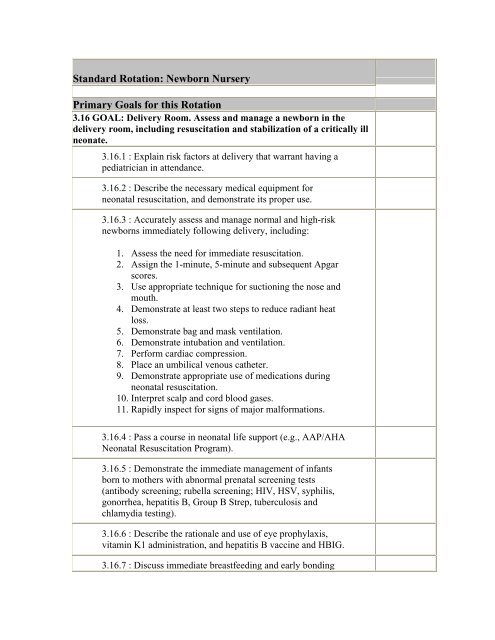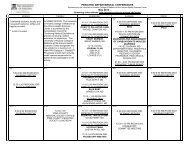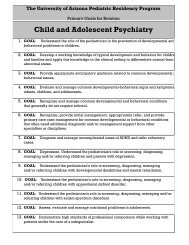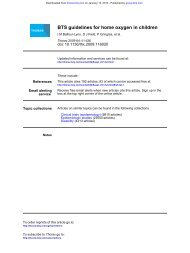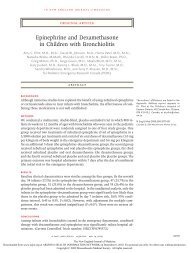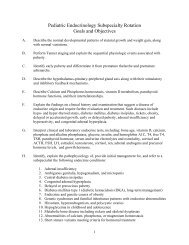Standard Rotation: Newborn Nursery Primary Goals for this Rotation
Standard Rotation: Newborn Nursery Primary Goals for this Rotation
Standard Rotation: Newborn Nursery Primary Goals for this Rotation
Create successful ePaper yourself
Turn your PDF publications into a flip-book with our unique Google optimized e-Paper software.
<strong>Standard</strong> <strong>Rotation</strong>: <strong>Newborn</strong> <strong>Nursery</strong><br />
<strong>Primary</strong> <strong>Goals</strong> <strong>for</strong> <strong>this</strong> <strong>Rotation</strong><br />
3.16 GOAL: Delivery Room. Assess and manage a newborn in the<br />
delivery room, including resuscitation and stabilization of a critically ill<br />
neonate.<br />
3.16.1 : Explain risk factors at delivery that warrant having a<br />
pediatrician in attendance.<br />
3.16.2 : Describe the necessary medical equipment <strong>for</strong><br />
neonatal resuscitation, and demonstrate its proper use.<br />
3.16.3 : Accurately assess and manage normal and high-risk<br />
newborns immediately following delivery, including:<br />
1. Assess the need <strong>for</strong> immediate resuscitation.<br />
2. Assign the 1-minute, 5-minute and subsequent Apgar<br />
scores.<br />
3. Use appropriate technique <strong>for</strong> suctioning the nose and<br />
mouth.<br />
4. Demonstrate at least two steps to reduce radiant heat<br />
loss.<br />
5. Demonstrate bag and mask ventilation.<br />
6. Demonstrate intubation and ventilation.<br />
7. Per<strong>for</strong>m cardiac compression.<br />
8. Place an umbilical venous catheter.<br />
9. Demonstrate appropriate use of medications during<br />
neonatal resuscitation.<br />
10. Interpret scalp and cord blood gases.<br />
11. Rapidly inspect <strong>for</strong> signs of major mal<strong>for</strong>mations.<br />
3.16.4 : Pass a course in neonatal life support (e.g., AAP/AHA<br />
Neonatal Resuscitation Program).<br />
3.16.5 : Demonstrate the immediate management of infants<br />
born to mothers with abnormal prenatal screening tests<br />
(antibody screening; rubella screening; HIV, HSV, syphilis,<br />
gonorrhea, hepatitis B, Group B Strep, tuberculosis and<br />
chlamydia testing).<br />
3.16.6 : Describe the rationale and use of eye prophylaxis,<br />
vitamin K1 administration, and hepatitis B vaccine and HBIG.<br />
3.16.7 : Discuss immediate breastfeeding and early bonding
etween baby and family and describe how hospital routines<br />
can facilitate or impede these natural processes.<br />
3.16.8 : Describe how obstetricians and pediatricians can<br />
communicate and work together as a team to improve<br />
outcome at high-risk deliveries.<br />
3.16.9 : Discuss prevalence and infant health issues of home<br />
deliveries by nurse midwives in one's own community.<br />
3.16.10 : Recognize the risks and liabilities of home birth, as<br />
well as ways the nurse midwife and pediatrician can work<br />
together to benefit the infant born at home.<br />
3.16.11 : For these common conditions, demonstrate delivery<br />
room assessment and management; and manage newborns<br />
independently; and list criteria <strong>for</strong> consultation or transfer to<br />
level II or III nursery:<br />
1. Meconium stained fluid<br />
2. Respiratory depression and other common effects of<br />
maternal anesthesia, medications, or substance<br />
use/abuse<br />
3. Complicated labor (e.g., decelerations, maternal<br />
hypertension)<br />
4. Complicated delivery (e.g., problems with Cesarean<br />
Section, instrument-assisted deliveries, breech<br />
presentation, cord prolapse, placenta abruption, oligoor<br />
polyhydramnios, precipitous deliveries)<br />
5. Cyanosis, respiratory distress or heart murmur<br />
6. Cardiorespiratory depression or abnormal blood gases<br />
3.16.12 : Describe the care and treatment of an infant<br />
following delivery that occurred unexpectedly at home or in<br />
transit to hospital.<br />
3.17 GOAL: Comprehensive Care in Level I <strong>Nursery</strong>. Provide<br />
comprehensive care in a level I nursery.<br />
3.17.1 : Explain the role of the primary care pediatrician in the<br />
level I nursery and how it relates to the continuum of office<br />
health supervision care.<br />
3.17.2 : Effectively communicate with the mother's<br />
obstetrician during the hospital stay and her primary care<br />
provider prior to the infant's discharge.<br />
3.17.3 : Describe normal physiologic changes in neonatal
transition, signs of abnormal responses and strategies <strong>for</strong> their<br />
management.<br />
3.17.4 : Describe the rationale behind various nursery and<br />
delivery routines and how these affect the health and wellbeing<br />
of families and newborns (e.g., rooming in, on-demand<br />
feeding, 24 hour discharge of the newborn, glucose water<br />
feeds).<br />
3.17.5 : Function as a pediatric consultant to health<br />
professionals in the newborn nursery, obstetrical ward, and<br />
delivery room <strong>for</strong> routine, normal pregnancies, deliveries and<br />
newborn care.<br />
3.17.6 : Identify the role and scope of practice of general<br />
pediatricians, neonatologists, perinatologists, obstetricians,<br />
family physicians, nurse midwives, lactation consultants,<br />
primary care nurses <strong>for</strong> OB/<strong>Newborn</strong>, and social workers in<br />
relation to the normal nursery; and work collaboratively with<br />
these professionals in the care of newborns.<br />
3.18 GOAL: Assessment, Screening and Prevention (Normal <strong>Newborn</strong>s).<br />
Assess newborns, using history, physical exam and routine screening<br />
procedures, and provide preventive counseling and intervention as<br />
indicated.<br />
3.18.1 : Obtain and interpret in<strong>for</strong>mation relevant to newborn<br />
health including:<br />
1. Maternal medical, prenatal and obstetric history<br />
2. Family history<br />
3. Results of maternal screening tests (e.g, Rh), rubella,<br />
hepatitis B and C, serology <strong>for</strong> syphilis, HIV,<br />
tuberculosis, illicit drugs, blood type, group B<br />
streptococcus, herpes simplex virus, gonorrhea, and<br />
chlamydia<br />
4. Maternal medication use or substance use/abuse<br />
5. Results of prenatal ultrasound testing<br />
3.18.2 : Obtain and interpret a social history to assess the<br />
physical and psychosocial environment in the infant's home.<br />
3.18.3 : Understand and demonstrate appropriate timing <strong>for</strong><br />
newborn exams and define the key reasons <strong>for</strong> doing the<br />
exams (e.g., determine state of transition, assess risks, identify<br />
abnormalities, and demonstrate normal findings and behaviors<br />
to parents).
3.18.4 : Per<strong>for</strong>m a neonatal physical examination and identify<br />
normal and abnormal findings related to:<br />
1. Gestational age assessment and growth category<br />
(AGA, SGA, LGA)<br />
2. Vital signs and measurements<br />
3. General appearance and identification of anomalies<br />
4. HEENT (red reflex, intact palate, short frenulum,<br />
caput, cephalohematoma)<br />
5. Neck and clavicles<br />
6. Neurologic system (symmetry, tone, reflexes, suck,<br />
behavioral state, head size and shape, spine)<br />
7. Respiratory ef<strong>for</strong>t<br />
8. Skin<br />
9. Chest and breasts<br />
10. Heart<br />
11. Lungs<br />
12. Abdomen (including umbilical cord)<br />
13. Genitalia<br />
14. Femoral and brachial pulses<br />
15. Hips (Ortolani and Barlow maneuvers)<br />
16. Extremities<br />
3.18.5 : Describe current standards <strong>for</strong> newborn screening,<br />
including:<br />
1. National (AAP) recommendations <strong>for</strong> universal<br />
newborn hearing screening<br />
2. State neonatal blood-screening program, including<br />
diseases screened <strong>for</strong>, timing, testing procedures and<br />
process <strong>for</strong> notification of abnormal results<br />
3. Current recommendations <strong>for</strong> maternal Group B<br />
Streptococcus screening and the evaluation of exposed<br />
neonates<br />
4. Appropriate use of other screening tests or protocols<br />
and their indications (e.g., blood type and Coombs,<br />
glucose, hematocrit)<br />
5. Appropriate use of testing to identify prenatal<br />
exposure to substances of abuse<br />
3.18.6 : Communicate effectively with parents and family in a<br />
professional and caring manner that honors family values and<br />
enhances their parenting skills and confidence.<br />
3.18.7 : Provide anticipatory guidance and prevention
counseling throughout hospital stay and at time of discharge,<br />
according to recommended guidelines (e.g., AAP, Bright<br />
Futures).<br />
3.19 GOAL: Common Signs and Symptoms (Normal <strong>Newborn</strong>s).<br />
Evaluate and appropriately treat or refer newborns with these<br />
commonly presenting signs and symptoms.<br />
3.19.1 : Recognize, describe clinical significance of, and<br />
develop a strategy to evaluate, manage and/or refer newborns<br />
with these common newborn signs and symptoms:<br />
1. Large birth marks (mongolian spots, hemangiomas,<br />
port wine spots)<br />
2. Rashes and markings secondary to birth trauma<br />
3. Papular and pustular rashes (erythema toxicum,<br />
pustular melanosis, staph. Pustulosis, milia)<br />
4. Peripheral and central cyanosis<br />
5. High or low temperature<br />
6. Tachypnea<br />
7. Heart murmur-asymptomatic and symptomatic<br />
8. Abdominal distension and masses<br />
9. Two vessel umbilical cords<br />
10. Abnormal findings on the Barlow or Ortolani<br />
11. Swollen breasts<br />
12. Vaginal bleeding<br />
13. Subconjunctival hemorrhages<br />
14. Corneal opacities or absent red reflex<br />
15. Facial palsy<br />
16. Fractured clavicle<br />
17. Brachial plexus injury<br />
18. Cephalohematoma or caput<br />
19. Ear tags, pits<br />
20. Palate abnormalities (cleft, submucous cleft)<br />
21. Polydactyly<br />
22. Syndactyly<br />
23. Plethora<br />
24. Pallor<br />
25. Respiratory distress<br />
26. Abnominal mass<br />
27. Genitourinary abnormalities (ambiguous genitalia,<br />
hypospadius, undescended testicle)<br />
28. Microcephaly<br />
29. Macrocephaly<br />
30. Sacral dimple, pit, hair tuft<br />
3.20 GOAL: Common Conditions (Normal <strong>Newborn</strong>s). Evaluate and
appropriately treat or refer newborns with these commonly presenting<br />
conditions.<br />
3.20.1 : Recognize, describe clinical significance of, and<br />
develop a strategy to evaluate, manage and/or refer newborns<br />
with the following common newborn clinical situations:<br />
1. Large and/or small <strong>for</strong> gestational age babies<br />
2. Infant of a diabetic mother<br />
3. Infant of substance abusing mother<br />
4. Child with ABO/Rh incompatibility<br />
5. Polycythemia<br />
6. Premature/postmature infant<br />
7. Jitteriness<br />
8. Transient metabolic disturbances (hypoglycemia, etc.)<br />
9. Delayed urination<br />
10. Delayed stooling<br />
11. Vomiting feeds/bilious emesis<br />
12. Poor/delayed suck<br />
13. Respiratory distress with feedings<br />
14. Jaundice<br />
15. Infant with risk factor <strong>for</strong> DDH (girl breech, +family<br />
hx)<br />
16. Infant with abnormalities on prenatal ultrasound<br />
(pyelectasia, hydronephrosis, choroids plexus cyst)<br />
17. Dysmorphic infant or infant with known chromosomal<br />
abnormality (e.g., Trisomy 21)<br />
18. Multiple births (near and at term)<br />
19. Eye discharge<br />
20. Abnormal newborn hearing screen results<br />
21. Infant born to a mother with a significant medical<br />
condition (lupus, seizure disorder, obstetrical condition<br />
such as HELLP syndrome)<br />
3.20.2 : Use and/or interpret clinical tests commonly used in<br />
<strong>Newborn</strong> <strong>Nursery</strong> setting, such as:<br />
1. Physiologic monitoring (HR, RR, pulse oximetry,<br />
blood gas, doppler BP measurement)<br />
2. Dubowitz exam <strong>for</strong> gestational age assessment,<br />
premature and term infant growth curves<br />
3. CBC, ABO typing and Coombs testing, blood<br />
glucose/glucometer, bilirubin (serum and<br />
transcutaneous), maternal cord blood antibodies<br />
4. Xray of chest, abdomen
5. Ultra sound of kidneys/bladder, head, hips, lower spine<br />
3.20.3 : Be familiar with common assessment tools and<br />
studies used by obstetricians to assess normal pregnancies and<br />
infant well-being close to term and during the labor and<br />
delivery process.<br />
3.20.4 : Discuss common post-delivery obstetrical issues that<br />
mothers face, and how these affect their recovery and ability<br />
to care <strong>for</strong> their newborn:<br />
1. C-section delivery<br />
2. Tubal ligation<br />
3. Retention of placenta<br />
4. Post-partum hemorrhage<br />
5. Post-partum depression<br />
6. Post-partum infections<br />
7. Hypertension<br />
3.20.5 : Discuss care and communication issues <strong>for</strong> an infant<br />
being placed <strong>for</strong> adoption (including both birth and adoptive<br />
parents).<br />
3.21 GOAL: Nutrition (Normal <strong>Newborn</strong>s). Manage breast- and bottlefeeding<br />
in the newborn period.<br />
3.21.1 : Assess a newborn's nutritional status based on<br />
maternal medical and obstetrical history and infant's history<br />
(e.g., illness, feeding, stools, urination) and physical exam<br />
(e.g., weight expected <strong>for</strong> gestational age, subcutaneous fat,<br />
hydration, neurologic or oral/facial anomalies) and implement<br />
appropriate feeding plans.<br />
3.21.2 : Counsel parents about feeding choices and assess <strong>for</strong><br />
potential risks/difficulties.<br />
3.21.3 : Encourage and support mothers who are<br />
breastfeeding.<br />
3.21.4 : Counsel and support mothers who are <strong>for</strong>mula<br />
feeding.<br />
3.21.5 : Refer mothers to WIC and other resources <strong>for</strong><br />
assistance with food purchase, nutrition education, and<br />
breastfeeding support equipment.<br />
3.21.6 : Recognize and manage these conditions:
1. Common problems <strong>for</strong> breastfeeding infants and<br />
mothers<br />
2. Maternal use of medications that are transmitted via<br />
breast milk<br />
3. Maternal infections and risk of transmission (Hepatitis<br />
B, Hepatitis C, HIV)<br />
4. Preserving breastfeeding while managing jaundice<br />
5. <strong>Newborn</strong> who is a poor feeder<br />
6. Feeding plans <strong>for</strong> the SGA or premature infant<br />
7. Feeding plans <strong>for</strong> the infant of a diabetic mother<br />
8. Feeding plans <strong>for</strong> the infant with a cleft palate<br />
9. Feeding plans <strong>for</strong> neurologically depressed/abnormal<br />
newborn<br />
3.22 GOAL: Infections (Normal <strong>Newborn</strong>s). Assess and manage common<br />
infections in the normal newborn nursery.<br />
3.22.1 : Identify common and important perinatal infections.<br />
3.22.2 : Discuss methods <strong>for</strong> screening and, where<br />
appropriate, preventive treatment of mother and infant<br />
(chlamydia, CMV, gonorrhea, group B strep, hepatitis B,<br />
hepatitis C, HSV, HIV, tuberculosis, HPV, parvovirus,<br />
rubella, syphilis, toxoplasmosis, and varicella).<br />
3.22.3 : Identify newborns at risk <strong>for</strong> bacterial sepsis by<br />
history, physical exam, and laboratory studies.<br />
3.22.4 : Practice the AAP/ACOG accepted policies <strong>for</strong><br />
infection reduction in the newborn nursery.<br />
3.22.5 : Describe why umbilical cord care is routinely<br />
per<strong>for</strong>med and what methods are available.<br />
3.22.6 : Counsel parents about recommendations on routine<br />
Hepatitis B vaccination, including risks, benefits, alternatives,<br />
and common side effects.<br />
3.22.7 : Recognize and manage:<br />
1. <strong>Newborn</strong> with signs of sepsis (e.g., fever, poor<br />
feeding, tachypnea, low temperature)<br />
2. Infant born to mother with fever<br />
3. Infant born to mother with a history of a perinatal<br />
infectious disease (e.g., group B strep, chlamydia,<br />
syphilis, HSV)<br />
4. Infant born to mother with prolonged rupture of
membranes<br />
5. Infant born to mother who received antibiotic during<br />
delivery<br />
3.23 GOAL: Jaundice. Recognize and manage jaundice in the newborn<br />
period.<br />
3.23.1 : Interpret maternal history <strong>for</strong> factors contributing to<br />
jaundice (Rh, blood type, gestational age, infection, family<br />
history of jaundice in infants, etc.).<br />
3.23.2 : Interpret infant's history <strong>for</strong> possible etiologies of<br />
jaundice (e.g., infrequent or ineffective feeding, poor urine or<br />
stool output, acholic stool, blood type, risk factors <strong>for</strong><br />
infection, metabolic disease).<br />
3.23.3 : Per<strong>for</strong>m a physical exam to assess <strong>for</strong> jaundice or<br />
other evidence of hepatic dysfunction (e.g., skin color, sclerae,<br />
bruising, cephalhematoma, organomegaly).<br />
3.23.4 : Demonstrate use and interpretation of transcutaneous<br />
bilirubin monitoring.<br />
3.23.5 : Obtain laboratory tests judiciously <strong>for</strong> management of<br />
the jaundiced infant (blood type/Coombs, total, fractionated<br />
bili, Hct, peripheral blood smear).<br />
3.23.6 : Correctly interpret test results to evaluate jaundice in<br />
the clinical setting.<br />
3.23.7 : Counsel parents about types of jaundice (physiologic,<br />
insufficient breastfeeding, breast milk, hemolytic, etc.) and<br />
their natural history.<br />
3.23.8 : Counsel parents about when to be concerned about<br />
jaundice (e.g., icterus beyond the face and chest, poor feeding,<br />
fever, irritability).<br />
3.23.9 : Discuss the current AAP practice parameters<br />
regarding diagnosis and management of the jaundiced infant.<br />
3.23.10 : Interpret the significance of a total serum bilirubin<br />
level in the context of early discharge of newborns, with<br />
reference to normative data based on age in hours.<br />
3.23.11 : Describe indications <strong>for</strong> phototherapy and exchange<br />
transfusions.
3.23.12 : Describe the use of phototherapy in both the hospital<br />
and the home and explain risks (e.g., dehydration, eye injury,<br />
and disruption of breastfeeding routines).<br />
3.23.13 : Counsel parents about ways to improve jaundice at<br />
home (e.g. frequent feedings, exposure to sunlight, etc.).<br />
3.24 GOAL: Anticipatory Guidance at <strong>Nursery</strong> Discharge. Provide<br />
anticipatory counseling at nursery discharge that relates to newborn<br />
behavior, family adjustment, injury prevention, and access to medical<br />
services.<br />
3.24.1 : Discuss priorities <strong>for</strong> anticipatory counseling,<br />
especially in face of time constraints due to "early discharge."<br />
3.24.2 : List resources that can be used to supplement<br />
counseling by the physician.<br />
3.24.3 : Provide routine counseling on topics such as:<br />
1. Routine follow-up appointment time (e.g., 3-5 days of<br />
age <strong>for</strong> early discharge and breastfeeding infants)<br />
2. How and when to contact the office <strong>for</strong> advice or<br />
earlier appointment<br />
3. For infants discharged early: warning signs of<br />
jaundice, infection, dehydration, and feeding<br />
problems; interaction with visiting nurse, need to do<br />
repeat newborn screening blood tests<br />
4. Needed medical, social, and WIC services<br />
5. Normal infant behaviors related to crying, sleep, and<br />
wakefulness and how to deal with common problems<br />
(hiccups, sneezes, vaginal bleeding, breast<br />
masses/discharge, care of umbilical cord, care of<br />
penis)<br />
6. Postpartum adjustment including the need <strong>for</strong> rest and<br />
support, and the potential <strong>for</strong> postpartum "blues" (e.g.,<br />
depression, anxiety, feelings of inadequacy, fear,<br />
resentment)<br />
7. Uniqueness of each infant's temperament and how to<br />
identify and respond to <strong>this</strong><br />
8. Potential <strong>for</strong> sibling rivalry and ways to handle <strong>this</strong><br />
9. Injury prevention (e.g., car seat <strong>for</strong> discharge, crib<br />
safety, water temperature settings, smoke alarm,<br />
constant supervision of newborn with siblings or pets,<br />
sleep position, environmental exposures like cigarette<br />
smoke)<br />
10. Significance of increasing jaundice, feeding problems
or fever in <strong>this</strong> age group and the rapidity with which<br />
medical care should be sought<br />
3.24.4 : Provide written discharge instructions, documentation<br />
of immunization (HBV) given, and results of hearing screen.<br />
3.25 GOAL: Pediatric Competencies in Brief (Normal <strong>Newborn</strong>s).<br />
Demonstrate high standards of professional competence while working<br />
with patients in the normal newborn nursery. [For details see Pediatric<br />
Competencies.]<br />
3.25.1 : Competency 1: Patient Care. Provide family-centered<br />
patient care that is development- and age-appropriate,<br />
compassionate, and effective <strong>for</strong> the treatment of health<br />
problems and the promotion of health.<br />
3.25.1.1 :Use a logical and appropriate clinical<br />
approach to the care of newborns, applying<br />
principles of evidence-based decision-making and<br />
problem-solving.<br />
3.25.1.2 :Provide sensitive support to patients and<br />
their families in the delivery room and level 1 and 2<br />
newborn nursery.<br />
3.25.2 : Competency 2: Medical Knowledge. Understand the<br />
scope of established and evolving biomedical, clinical,<br />
epidemiological and social-behavioral knowledge needed by a<br />
pediatrician; demonstrate the ability to acquire, critically<br />
interpret and apply <strong>this</strong> knowledge in patient care.<br />
3.25.2.1 :Demonstrate a commitment to acquiring<br />
the knowledge needed <strong>for</strong> the care of newborns in<br />
the delivery room and level 1 and 2 nursery.<br />
3.25.2.2 :Know and/or access medical in<strong>for</strong>mation<br />
efficiently, evaluate it critically, and apply it to<br />
newborn care appropriately.<br />
3.25.3 : Competency 3: Interpersonal Skills and<br />
Communication. Demonstrate interpersonal and<br />
communication skills that result in in<strong>for</strong>mation exchange and<br />
partnering with patients, their families and professional<br />
associates.<br />
3.25.3.1 :Provide effective patient education,<br />
including reassurance, <strong>for</strong> condition(s) common to<br />
the newborn nursery.<br />
3.25.3.2 :Communicate and work effectively with
staff, health professionals, specialists, referring and<br />
primary care providers to create and sustain<br />
in<strong>for</strong>mation exchange and teamwork <strong>for</strong> patient<br />
care.<br />
3.25.3.3 :Develop effective strategies <strong>for</strong> teaching<br />
students, colleagues and other professionals.<br />
3.25.3.4 :Maintain accurate, legible, timely, and<br />
legally appropriate medical records <strong>for</strong> newborns<br />
(summary of maternal record, labor and delivery<br />
note, admission note, daily progress notes,<br />
consultant notes and discharge summaries).<br />
3.25.4 : Competency 4: Practice-based Learning and<br />
Improvement. Demonstrate knowledge, skills and attitudes<br />
needed <strong>for</strong> continuous self-assessment, using scientific<br />
methods and evidence to investigate, evaluate, and improve<br />
one's patient care practice.<br />
3.25.4.1 :Use scientific methods and evidence to<br />
investigate, evaluate, and improve patient care<br />
practice in the nursery setting.<br />
3.25.4.2 :Identify standardized guidelines <strong>for</strong><br />
diagnosis and treatment of conditions common to<br />
the newborn nursery, and adapt them to the<br />
individual needs of specific patients.<br />
3.25.4.3 :Identify personal learning needs,<br />
systematically organize relevant in<strong>for</strong>mation<br />
resources <strong>for</strong> future reference, and address plans<br />
<strong>for</strong> lifelong learning about newborn care.<br />
3.25.5 : Competency 5: Professionalism. Demonstrate a<br />
commitment to carrying out professional responsibilities,<br />
adherence to ethical principles, and sensitivity to diversity.<br />
3.25.5.1 :Demonstrate personal accountability to<br />
the well-being of patients (e.g., following-up on lab<br />
results, writing comprehensive notes, and seeking<br />
answers to patient care questions).<br />
3.25.5.2 :Demonstrate a commitment to<br />
professional behavior in interactions with staff and<br />
professional colleagues.<br />
3.25.5.3 :Adhere to ethical and legal principles, and<br />
be sensitive to diversity.<br />
3.25.6 : Competency 6: Systems-Based Practice. Understand<br />
how to practice high-quality health care and advocate <strong>for</strong>
patients within the context of the health care system.<br />
3.25.6.1 :Demonstrate sensitivity to the costs of<br />
clinical care in the nursery, and take steps to<br />
minimize costs without compromising quality.<br />
3.25.6.2 :Recognize and advocate <strong>for</strong> families who<br />
need assistance during the hospital stay and after<br />
discharge.<br />
3.25.6.3 :Recognize one's limits and those of the<br />
system; take steps to avoid medical errors.<br />
Procedures<br />
7.1. GOAL: Technical and therapeutic procedures. Describe the<br />
following procedures, including how they work and when they should be<br />
used; competently per<strong>for</strong>m those commonly used by the pediatrician in<br />
practice.<br />
Bladder: catherization<br />
Breast pump use<br />
Capillary blood collection (PKU, hct)<br />
Circumcision<br />
Conjunctival swab<br />
Gastric tube placement (OG/NG)<br />
Lumbar puncture<br />
Medication delivery: IM/SC/ID<br />
Medication delivery: IV<br />
Pulse oximeter: placement<br />
Suctioning: nares<br />
Suctioning: oral pharynx<br />
Suctioning: trachea (newborn)<br />
7.2. GOAL: Diagnostic and screening procedures. Describe the following<br />
tests or procedures, including how they work and when they should be used;<br />
competently per<strong>for</strong>m those commonly used by the pediatrician in practice.<br />
Hearing screening
Source<br />
Monitoring interpretation: pulse oximetry<br />
Radiologic interpretation: chest X-ray<br />
Kittredge, D., Baldwin, C. D., Bar-on, M. E., Beach, P. S., Trimm, R. F.<br />
(Eds.). (2004). APA Educational Guidelines <strong>for</strong> Pediatric Residency.<br />
Ambulatory Pediatric Association Website. Available online:<br />
www.ambpeds.org/egweb. [Accessed 02/14/2008]. Project to develop <strong>this</strong><br />
website was funded by the Josiah Macy, Jr. Foundation 2002-2005.


